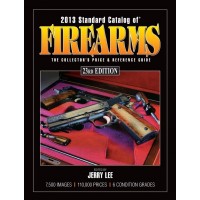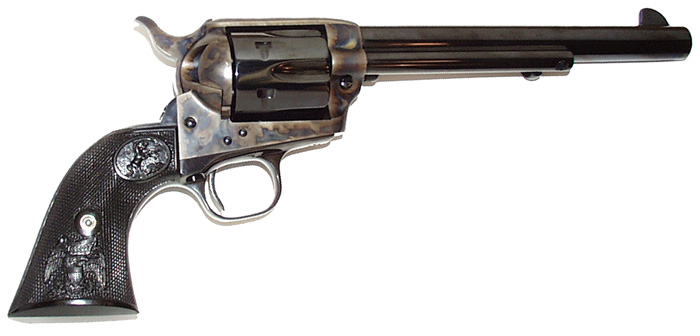Too Little, Too Late?
That was too bad. Most authorities agree that by about 1960, Great Western had a handle on its quality problems. Wilson had hired Dwayne Kastrup, a leading Colt SAA technician, as Great Western’s chief gunsmith. Kastrup’s influence was immediate and profound. In the second edition of Sixguns (1961), Keith sounded a conciliatory, admiring note.
“When we started this book, we could not recommend the Great Western Single Action,” he wrote. “Since then, we are happy to report Great Western has really gotten on the ball and is now cooking on all four burners. All the late manufacture Great Western single actions we have seen and tested are excellent arms: accurate, properly timed and adjusted and for the most part have good trigger pulls.”
Then came the stunner: “The Great Western Arms Company of California is now turning out better finished and fitted single actions than any we have seen from Colt,” Keith wrote.
It was quite a reversal of his earlier opinion. Stebbins was also sympathetic in his 1961 book.
“The Great Western Arms Company is ambitious and progressive,” he wrote. “It’s perfectly possible that they will build a single-action that’s of better quality than present or past Colts, as well as of more durable modern design. Some would even say, without qualification, that they now make the best.”
But the accolades were too little, perhaps, and certainly too late to help Great Western. Few firearms companies had fallen so far so quickly. By 1959, Great Western’s production of finished guns had become sporadic. Gun Digest stopped recognizing Great Western after its 1959 edition, and as far as I can tell, editor John Amber never gave it another thought.
In 1959, the assets of the moribund Great Western Arms Co. were purchased by gun importer E&M Co. (Early & Modern Firearms, now EMF). E&M attempted to carry on the Great Western name, promoting whatever finished goods remained in stock and heavily pushing the Great Western kits. A sales organization, Great Western Arms Sales Co., was established in North Hollywood, Calif. The company continued to promote Great Western products. However, by mid-1964, Great Western’s advertising was of a quality usually reserved for do-it-yourself earthworm farms.
Then, poof. Great Western winked out, going gentle into that good night.
What Remains
Because no production records remain, it’s difficult to construct a manufacturing chronology of Great Western’s final years. It seems likely that when E&M acquired Great Western, it marketed completed guns and then assembled what finished guns they could from parts. After that, kits and spare parts would have been all that remained. Such a scenario would explain the inconsistent nature of much of Great Western’s late production.
Today, EMF is a leading importer of single-action revolvers and other cowboy-action guns. Forty years after the demise of the original Great Western Arms Co., EMF still retains Great Western as a registered brand name. In a karmic gesture, EMF announced a new “Great Western II” single-action revolver line at the 2004 SHOT Show. The Great Western II is made in Italy by Pietta, and it continues that company’s reputation for outstanding quality and value.
It’s ironic: For 50 years, some people mistakenly said Great Westerns were made in Europe. Now they’re right!
EMF estimated that 50,000 total Great Western revolvers were made, including kit guns. That’s not a bad record, considering the company only manufactured guns for about eight years. That also means Great Westerns are scarce enough to excite collector interest.
Referring to the obsolete .225 Winchester cartridge, Frank C. Barnes once wrote in Cartridges of the World, “It might be well to hang on to your (.225 rifle) because not a great many were sold, and eventually some gun writer will rediscover it as the greatest .22 varmint cartridge conceived by the mind of man, and at that point all your shooting friends will wish they had one, too.”
A similar situation exists with Great Western revolvers. Once considered the pariah of single-actions, they’re now quite collectible.
That derives partly from Great Western’s status as the first Colt clone, partly from the relative scarcity of their guns, and partly from the high quality of most later examples. The bane of any small manufacturer is inconsistency, however, and the quality of existing Great Westerns is across the map.
My Great Western Frontier .38 Special is a good example. Bearing serial No. 17882, it is midproduction gun, probably from 1957 or 1958. Almost 50 years old and showing signs of heavy use, it is still tighter than many brand-new Colt clones. The click-click-click-click of its action is still crisp and positive. Fore- and-aft cylinder play is almost nonexistent, and its indexing is flawless. So what’s to criticize?
Its finish, that’s what. Although the gun has obviously been ridden hard and put away wet, enough of the original finish remains to make a judgment call. It actually has fingerprints in the cyanide-dip case-hardening on the frame, something I would not have thought possible. I don’t mean faint fingerprints, either. I mean permanent, indelible fingerprints sharp enough to scan into an FBI database.
The back of the hammer shows obvious tool marks. The cylinder base pin latch has burrs on it. Even looking past the holster wear, it’s obvious the revolver is not a jewel in the crown of Great Western. This has no effect on the gun’s shooting qualities — it’s as accurate as any single-action I’ve fired — but it makes me wish the company had spent a bit more time on fit and finish.
Recommended Resources for Gun Collectors:
 2013 Standard Catalog of Firearms, 23nd Edition
2013 Standard Catalog of Firearms, 23nd Edition

